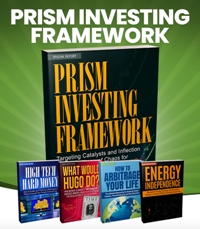 Trade tariff policies continue to drive uncertainty in financial markets. Stocks, bonds, and the dollar itself move to the daily words of Team Trump.
Trade tariff policies continue to drive uncertainty in financial markets. Stocks, bonds, and the dollar itself move to the daily words of Team Trump.
Are extreme tariff policies one of President Trump’s ‘art of the deal’ tactics? Or is the ground shifting beneath the feet of the global economy and financial markets?
This week, to the stock market’s delight, was all about damage control. Treasury Secretary Scott Bessent, while delivering remarks at the Institute of International Finance Global Outlook Forum, clarified that “America First does not mean America Alone.” This came a day after Bessent stated that the ongoing tariff showdown against China is “unsustainable” and that he expects a “de-escalation” in the trade war.
When you play with fire, you’re gonna get burned. In this regard, the initial damage has already been done. But, of course, there’s always more to come.
According to Port Optimizer, scheduled import volumes for the Port of Los Angeles for the week ending May 3 show a 28.53 percent week-over-week decline. What’s more, for the week ending May 10, scheduled import volumes are projected to be down 34.54 percent year-over-year.
Could this be the start of a long-term global trade contraction?
World trade cycles over the last 200 years have often expanded for such lengthy durations that people come to believe they’re permanent. These extended expansionary episodes compel people to think increasing global trade is a linear phenomenon. That it is destined to continue without interruption.
For example, trade as a share of global gross domestic product increased from about 25 percent in 1970 to 63 percent in 2022. Shouldn’t this increase in trade continue indefinitely?
Rise and Fall
One must go back to pre-1960 in the United States, Japan, and Western Europe to find someone with living memory of a global trade contraction. China’s latest trade expansion began in the 1970s. Eastern Europe’s began in the early 1990s.
But if you take a gander back to the first half of the 20th century you will discover something that goes counter to your life experience. Global trade, as a proportion of total economic activity, went down between the onset of World War I and the 1960s. That’s a 50-year period of contracting global trade.
Geopolitical shocks, like the breakup of the classical gold standard at the onset of the Great War, coincided with the start of this decline in global trade. Then, furthering the contraction, Eastern Europe suffered rampant hyperinflation in the 1920s while in the USA the inflation manifested in an epic stock market bubble.
When those burned out, and the world spiraled into the Great Depression, the Smoot-Hawley Tariff Act of 1930, and tit for tat retaliatory tariffs, destroyed what remained of global trade. This also presaged the start of World War II.
Not until well after WWII did international trade pick back up. This trade, while hesitant at first, blossomed during the latter part of the 20th century. But it doesn’t mean trade will continue to expand indefinitely.
Geopolitical shocks, as noted above, have periodically disrupted or reversed overall long-term trends in expanding global trade. Right now, the potential for multiple geopolitical shocks – including trade tariffs, currency chaos, and both cold and hot wars – that interrupt or reverse the global trade expansion that has been in place since the 1960s is extremely high.
In fact, at this very moment, it’s likely that we’ve already entered another long-term global trade contraction.
Economic Metamorphosis
The impetus of the trade contraction is a politically motivated trade war brought on by President Trump’s trade tariffs. This week’s damage control is not the end of the trade war. Not by a long shot.
To be clear, the trade war will have major consequences for the economy, supply chains, and the overall production and distribution of goods and services.
What this means is that we’re entering a period where the world is in the process of transforming into something much different than what people know and expect. You will see it with your eyes and feel it in your pocketbook when shopping at Walmart or Costco. It may even change how you go about earning your daily bread.
Trump believes the transformation will give working Americans a fair shake and a decent wage. We aren’t so sure.
What we do know is that the USA and its trading partners are entering an economic metamorphosis. Like a caterpillar forming a chrysalis, on again off again trade tariffs and trade tariff threats, are turning economic activity inward.
Inside the casing that’s created by trade barriers, a transformation will occur. Old, established relationships that were built up over many decades will rapidly break down and die out. At the same time, new specialized domestic producers will develop.
Will a beautiful butterfly emerge from the chrysalis and take flight? Or will it be an ugly nighttime moth that dives into a flame and to its own demise?
In general, a trade war triggers a painful economic metamorphosis. Initially, artificial price spikes on imported goods occur. Soon those foreign made goods disappear from store shelves.
This may give domestic producers the edge they need to enter the market. But this benefit comes at the expense of American consumers who pay higher prices and have less choices. In effect, American consumers end up subsidizing domestic production.
More importantly, producing products domestically that foreign manufacturers can produce cheaper, misallocates capital. Resources that could be better spent elsewhere are applied to businesses and sectors that are artificially protected.
While the government intervention may create some jobs, these are jobs that shouldn’t exist in the first place.
Make Depressions Great Again
The economic metamorphosis further transforms as the trade war escalates. Retaliatory tariffs imposed on American exporters destroy their businesses. Foreign markets no longer desire American made goods at their artificially higher prices.
American exporters are then forced to adjust their production. Namely, they must scale back their operations and layoff workers. They may also find that the raw material inputs that are imported become more expensive. This further disrupts production and raises prices for both domestic and foreign consumers.
In short, the entire structure of production and consumption is distorted. Artificial incentives reallocate resources away from efficient global producers to less efficient domestic producers. This reduces the overall productive capacity and ultimately it reduces the standard of living for everyone.
The uncertainty that results from a trade war also discourages long-term capital investment. Businesses, taking a ‘wait and see’ approach, delay projects because the rules of international trade keep changing. This further restricts innovation and economic growth.
Trade wars, in essence, force the economy to adapt and transform to an artificial world. This metamorphosis isn’t the result of adjusting to natural changes in market driven supply and demand. Rather, it’s an inefficient and unnecessary restructuring that’s caused by government intervention.
The metamorphosis ultimately leads to a less productive, less efficient, and weaker economy than an economy guided by free and voluntary exchange. Any benefits to certain domestic industries are outweighed by the increased costs imposed on consumers and other – non-preferred – domestic producers.
President Trump, with his Liberation Day tariff program, has started something that he cannot stop. The economic metamorphosis – a bifurcation between east and west – is already underway. Global trade is contracting. Supply chains are breaking down.
This is exactly what Trump wanted. However, it is not what his wealthy supporters, and their fat stock portfolios want.
This week’s damage control may make good headlines. It may also push stock market indexes higher – at least temporarily. But it cannot reverse the metamorphosis that’s already taking place.
It can, however, interrupt and retard it, thus stretching out the transformation. This is an important point.
Political prevarication, like now, is how recessions become depressions…and how depressions are made great.
[Editor’s note: Have you ever heard of Henry Ford’s dream city of the South? Chances are you haven’t. That’s why I’ve recently published an important special report called, “Utility Payment Wealth – Profit from Henry Ford’s Dream City Business Model.” If discovering how this little-known aspect of American history can make you rich is of interest to you, then I encourage you to pick up a copy. It will cost you less than a penny.]
Sincerely,
MN Gordon
for Economic Prism





I suppose with your infinite and undeniable wisdom, you should be the economic leader of the world. A world that finds it better to let China or anyone else “completely” supplant US production of any and all everything that we consume in this country from a general manufacturing prospective. Of course this has nothing to the TRILLIONS of debt that we owe as a result of trade disparity. God you’re smart! Boy!
1) Gordon has expressed no thoughts on whether what Trump is doing is necessary wrt China. He is simply commenting on the likely consequences of the path Trump has adopted. (A path btw that Trump seems to be making up as he goes along, given how often his position changes)? If you dislike what Gordon says here you need to attack the things he has actually said rather than things he hasn’t.
2) Like or loathe China, it has unquestionably made the world wealthier by driving down the cost of goods and increasing their availability for everyone. All Americans and everyone else are richer for that.
3) China is not the cause of the West’s trillions in indebtedness (which is largely governmental). China did not ask or force the US Government to spend more than it earns. The rich and powerful in the US did that, by adopting policies that enriched the few at the expense of the many. Having offshored manufacturing the US could have very easily invested in domestic activities that would have benefited the country, the masses and the world at large. Instead it enriched a predatory financial class and pissed away the benefits, all of which hollowed out the country’s productive capacity. If you want prosperity then you must invest in education, infrastructure, mutually rewarding relationships, ethics, etc, and not in war, financialisation and graft (gaming the system). China has done those things whilst the US has done the opposite. China didn’t make you do that. The people who did were American and they made millions lining their pockets in the process.
4) Nothing that Gordon says here is unreasonable. It is a logical interpretation of events from a basic and rational economics perspective. If it seems any way unwelcome and/or unreasonable that is more a reflection of just how broken America has become – overwhelmed by propaganda, ignorance and delusion. A bastardised form of Keynesianism has supplanted basic Austrian common sense because it serves the interests of those who exploit the system. The system won’t be fixed until the masses understand who is really ripping them off and demand frank, intelligent analysis of the problems, and honest, capable leadership to sort out the mess. Trump gets points for effort but little more. Whilst that it probably better than any of the alternatives of the last few years it seems unlikely to be enough. The US is likely heading towards crisis.
Democrats and RINOs are rooting for China, but Real Americans are Firmes Con Trump!
If we didn’t make products in America that customers in other nations want to buy, they wouldn’t trade with us. Before someone from “over there” can buy an American-made product, he must first make something that an American might want to buy and sell it here to get dollars. Take away his ability to earn dollars and there goes a sale to an American exporter hurting both parties.
Interesting comments but he left out the part that with the start of global trade acceleration around the early 1970’s began the stagnation of US workers wages. Yes it has been good for cheap goods and corporate profits but a disaster for the US worker.
China only acceded to the WTO in 2001. The US was offshoring jobs to Mexico, etc, a long time before then.
Something major happened in 1971 though. Maybe Nixon removing the convertibility of the $ into gold, which opened the door to US fiscal profigacy is mostly to blame? It’s rather telling how much richer the people closest to money printing have become, and how much relatively poorer those who haven’t participated directly in the US’ hyper-financialisation have become ever since.